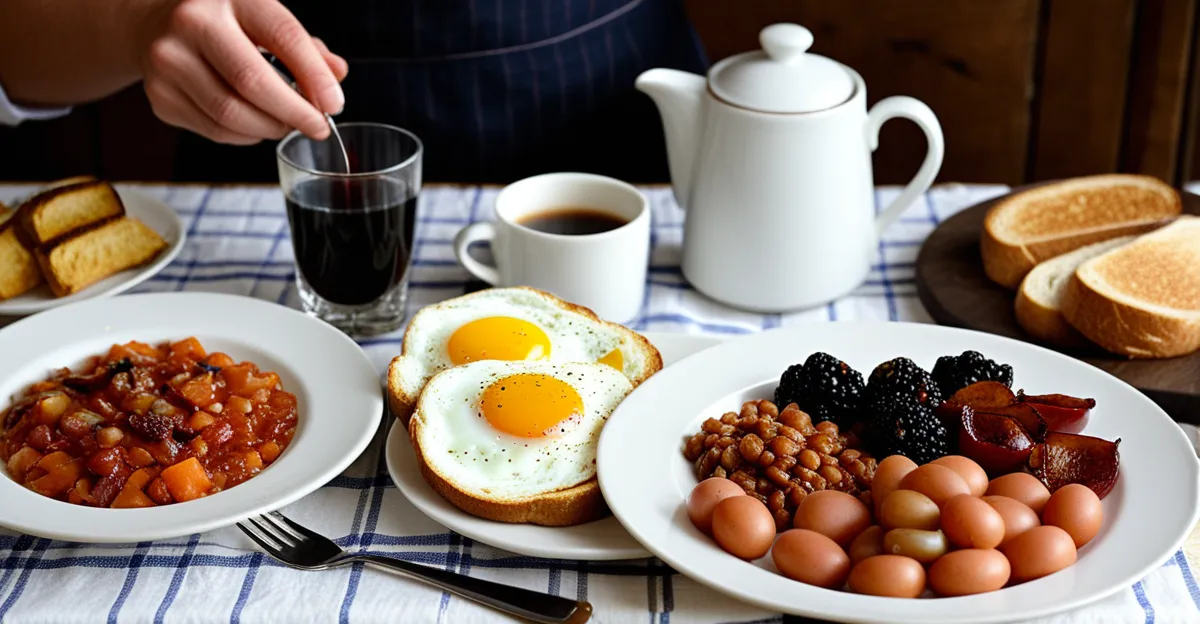Essential Ingredients for a Traditional English Breakfast
A traditional English breakfast relies on a distinct set of core ingredients that create its hearty and satisfying reputation. The full English breakfast staples include eggs, bacon, sausage, baked beans, grilled tomatoes, mushrooms, toast, and black pudding. Each component plays a vital role in delivering the authentic taste that many associate with this iconic morning meal.
For the best results, selecting fresh and high-quality ingredients is crucial. Choose sausages that are well-seasoned and free from artificial additives, while opting for smoked back bacon over streaky bacon adds a richer flavor. When it comes to black pudding, sourcing it from local butchers or reputable brands ensures genuine texture and taste. Fresh tomatoes and mushrooms should be firm and vibrant, and baked beans should preferably be gently simmered rather than microwaved to avoid losing flavor.
Also to see : How Has Traditional British Cuisine Influenced Modern Dining Trends?
Preparation techniques also affect freshness. For instance, lightly grilling tomatoes and mushrooms rather than frying maintains their moisture and enhances their natural flavors. Toast should be golden and crisp, complementing the softer textures on the plate. Using these traditional breakfast components thoughtfully creates the foundation required for an authentic English breakfast experience.
Step-by-Step Cooking Instructions for Each Component
Mastering how to cook English breakfast components is essential for a satisfying result. The traditional English breakfast preparation requires careful timing and method for each staple.
Also to discover : How Can Traditional UK Dishes Be Adapted for Healthier Lifestyles?
Start with the bacon: frying or grilling on medium heat until crispy edges develop but the meat stays juicy. For sausages, cook them slowly to an internal temperature of 160°F (71°C), turning frequently to avoid burning outside while ensuring fullness inside. Black pudding, a key traditional breakfast component, benefits from gentle frying until crisp outside and warm inside, preserving its rich texture.
Eggs are versatile; frying them sunny-side-up retains runny yolks, scrambling yields fluffy texture, and poaching offers a delicate finish. Each method suits different preferences but requires attention to avoid overcooking.
When preparing baked beans, warming slowly on low heat keeps the flavors intact. For grilled tomatoes, cut side down on a hot pan gives caramelized skin without excess moisture. Mushrooms benefit from quick sautéing in butter or oil to release their aromas without sogginess.
Lastly, toast should be golden and firm, ready to support the hearty ingredients. Following this step-by-step approach guarantees a balanced and flavorful full English breakfast experience with each staple cooked to perfection.
Pro Tips for Enhancing Flavor and Presentation
Achieving an authentic taste with your English breakfast requires more than just cooking the core ingredients well. Flavor enhancement and presentation elevate the experience. Start by layering subtle herbs like fresh parsley or thyme over mushrooms or tomatoes during cooking. This adds an aromatic depth without overpowering traditional breakfast components.
Using a pinch of black pepper or smoked paprika on eggs and sausages introduces gentle warmth and complexity to the plate. Consider integrating sauces such as HP Sauce or tomato ketchup served on the side to complement the savory staples, enhancing flavor rather than masking it.
Keeping components warm but not overcooked is key. Utilize a low oven (around 90°C/195°F) to hold cooked items such as bacon and sausages before serving. This avoids dryness and maintains mouthwatering texture.
For an inviting breakfast presentation, arrange items neatly yet informally on a warm plate, balancing colors and textures—crispy bacon next to golden toast, vibrant grilled tomatoes beside rich black pudding. This visual rhythm reflects the hearty yet approachable spirit of a full English breakfast. Properly applied flavor tips English breakfast paired with smart plating make a big difference in delivering a fulfilling and authentic morning meal.
Common Mistakes to Avoid
Ensuring a perfect traditional English breakfast involves steering clear of common English breakfast mistakes that compromise texture and flavor. A frequent error is overcooking bacon and sausages, resulting in dryness rather than the ideal juicy bite. Maintaining medium heat and constant attention prevents burnt edges while guaranteeing thorough cooking. Undercooking can be equally problematic with sausages posing health risks, so use a thermometer aiming for 160°F (71°C) internally.
Another pitfall is soggy mushrooms and tomatoes. Excess moisture from overcrowding pans or cooking at too low heat causes these staples to steam rather than grill or sauté. Ensuring a hot pan and cooking in small batches leads to caramelization that enhances flavor and presentation.
Timing errors often disrupt the meal; finishing some items early can cause cold, limp toast or cold eggs. Coordinating cooking order—for example, warming baked beans last on low heat while holding bacon and sausages at 90°C (195°F)—helps everything come together warm and fresh.
Avoid greasy results by draining excess fat after frying bacon and using minimal oil for mushrooms. These English breakfast troubleshooting tips refine your process, delivering consistent, satisfying breakfasts without compromising taste or texture.
Suggested Serving Styles and Accompaniments
Serving suggestions English breakfast focus on balancing tradition with personal preference. The classic English breakfast is best enjoyed plated with each traditional breakfast component arranged separately but harmoniously. This fry-up style allows diners to appreciate individual flavors such as crispy bacon, juicy sausages, and savory black pudding.
For a more communal approach, serving the full English breakfast on a large platter invites sharing and showcases the hearty bounty. Presentation remains important—warm plates maintain temperature, and neat arrangement highlights the colorful staples like grilled tomatoes and mushrooms.
Typical English breakfast side dishes include buttered toast for dipping runny eggs and baked beans, alongside condiments like tomato ketchup or HP Sauce. Tea or coffee are the customary beverages, with a strong, robust black tea complementing the savory spread perfectly.
For those seeking a personalized touch, adding homemade chutneys or a sprinkle of fresh herbs can elevate the plate without compromising authenticity. Health-conscious adaptations might suggest grilled rather than fried components or whole grain toast.
By combining traditional serving styles with thoughtful accompaniments, you create an inviting and satisfying meal that respects the classic flavors while encouraging a bit of creative flair. Using these serving suggestions English breakfast experts recommend ensures an enjoyable start to any morning.










